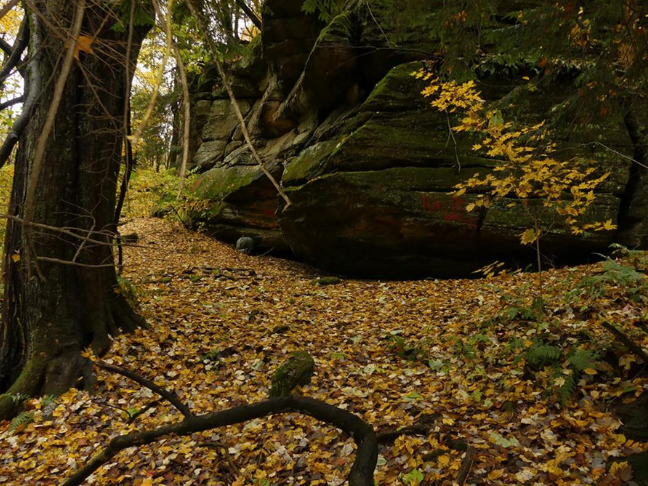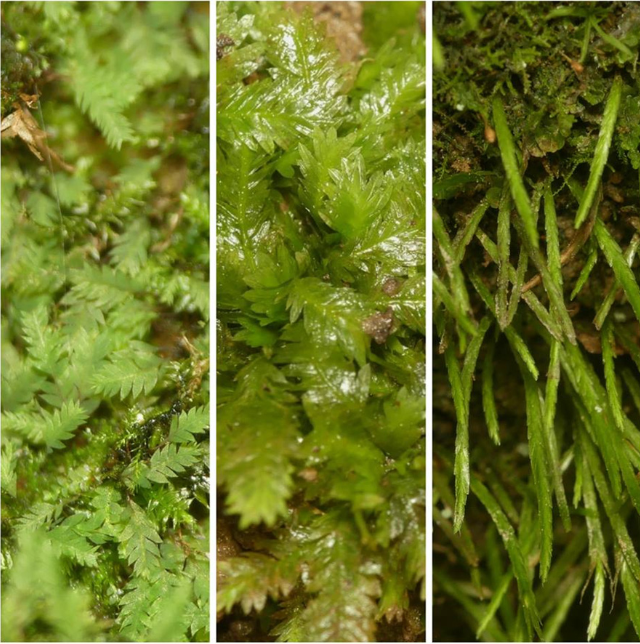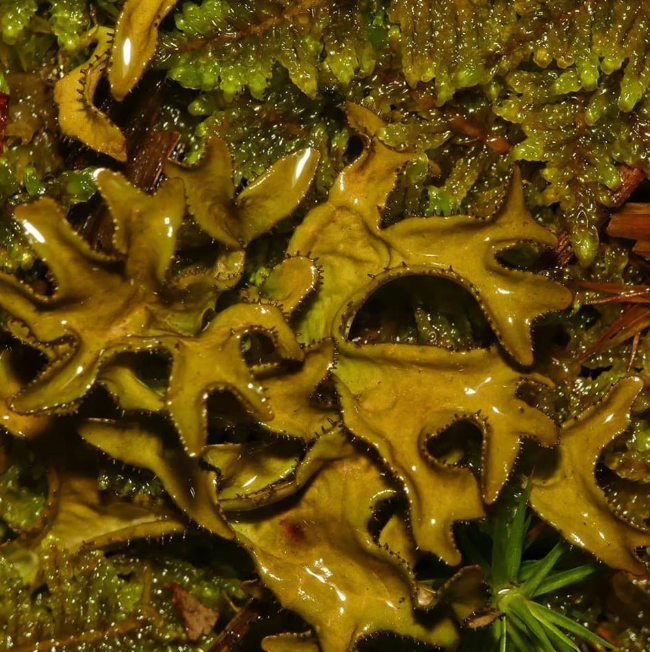Long Lost Moss Found (Alive)!
Goblin Gold (Schistostega pennata) is a one-of-a-kind moss that had been reported only twice before in Ohio with the last sighting occurring about 125 years ago. OMLA member Bob Klips had a “Wanted (Alive)” article on this elusive moss in the 2010 issue of OBELISK (1). It is quite the rarity. The two previous Ohio records were from Geauga and Portage Counties. One was a specimen recorded from Geauga County near Thompson. This specimen was collected in 1893 by Otto Hacker (2). The second record was a literature record reporting that it was discovered somewhere in Portage County, possibly in the Nelson Kennedy Ledges area. In his Wanted (alive) article, Klips mentions a 1919 paper in the Ohio Journal of Science by Edo Claassen titled “Mosses of Several Ohio Counties” (3). He mentions a record for Schistostega osmundacea (an early synonym for the species) for Portage County stating that it was found on the ground in a cave.
Schistostega pennata is a moss that has been searched for by many in Ohio through the years. I was first introduced to Thompson Ledges in northeast Geauga County by Tomas Curtis, because of its great lichen diversity. On June 29, 2018, I was taking a friend from Hocking College there to see some of the lichens. After exploring the top we entered a crack in the sandstone that leads to the base of the cliff. We worked our way along the base of the cliff searching for lichens and other plants. As we walked along I looked down and noticed a strange fluorescent green glow on the ground. The ground would only glow when we looked at it from a certain angle. I got down and gave it a closer look and sure enough I saw the feather-like gametophytes and immediately knew what it might be. I had heard of Goblin Gold before this point, but was no expert on it.

Schistostega pennata, Thompson Ledges. Photo by Shaun Pogacnick
As soon as I got home I started doing research and sent my pictures to Bob Klips, who responded quickly, was extremely enthusiastic about the find, and came up on July 3. He gave me the opportunity of collecting my first-ever specimen for a herbarium. This specimen has been deposited in the OSU Herbarium (catalog # OS0069081) (4). When word got out about this, Barbara Andreas and Diane Lucas also came up to see it! Barbara deposited a specimen in the Kent State University herbarium (catalog # KE B014611) (4).
The distribution map from the Consortium of North American Bryophyte Herbaria website shows that Schistostega pennata is scattered throughout North America, Asia, and Europe (4). The Thompson record is apparently one of the most southerly occurrences of it. It does not seem to be frequent anywhere in the world. The moss listed as a [G3G4, rounded to G3] which is globally vulnerable by Nature Serve (5). It is not currently ranked in Ohio since there had been no recent records. According to Nature Serve it is not common anywhere. They estimate there to be about 300 occurrences worldwide with only 40 occurrences that have good viability. They estimate 2,500-10,000 individual plants worldwide. Nature Serve is composed of a group of biodiversity scientists who believe it is important to have the best information available when making conservation decisions. They have compiled the information to make it available to everyone.

The ledge where the Schistostega resides. Photo by Shaun Pogacnick
Its habitat is varied. It has been described as occurring on mineral soils in crevices, in caves, on upturned root wads, and animal burrows (6). Where I found it, it was in dark wet crevices on Sharon Conglomerate sandstone and also on the ground below the sandstone ledges. It prefers to be in very damp humid locations, however it does not tolerate extreme wetness. If an area is too wet or too dry, the moss will disappear.
The habitat at Thompson Ledges is at the base of steep east-facing sandstone cliffs, shaded by eastern hemlock (Tsuga canadensis), yellow birch (Betula alleghaniensis), sugar maple (Acer saccharum) and mountain maple (A. spicatum). The moss favors damp areas near seeps at the base of the cliff. One particular spot where I first discovered the moss was very mucky adjacent to it. The moss grew on soil that was damp, but not wet. This was where it first caught my eye. The seep in this area had an overhanging ledge that was less than 2 feet off the ground and extended to about 8 feet deep. Upon closer examination of this ledge I discovered some of the gametophytes growing right on the overhanging sandstone in a shallow crevice. Sporophytes were present but scarce. I also found a second location a little north of the original site. I examined ledges on the other side of the park north of the road which is less frequently used. There, I discovered two more populations which were much smaller. These populations were found in shallower overhangs along cracks of the sandstone. These locations were also damp.
Schistostega pennata is the only member of a single-species family Schistostegaceae and is an acrocarp moss. It can be confused with Fissidens spp. which have similar gametophytes that have two-ranked leaves.
On the gametophytes of Schistostega, the leaves are nerveless, while those of Fissidens will have a distinct midrib. Sword moss (Bryoxiphium norvegicum) has the same leaf arrangement as well but the gametophytes are much more slender. The 3 mosses are pictured below for comparison.

From left to right Schistostega, Fissidens, Bryoxiphium.
They could also possibly be confused with Caylpogeia spp. liverworts which are also nerveless. Liverworts, however lack the peristome that is typical of mosses (7). What is unique about Schistostega is the persistent protonema. A protonema is a thread-like structure that is formed in the earliest stage (the haploid phase) in the life cycle of a moss. It forms “buds” which may turn into mosses. It is formed from a spore. In most mosses, the protonema disappears fairly quickly. In Schistostega, the protonema remains for some time and it also has flat outgrowths that develop perpendicular to the light. Inside these are spherical cells that act as lenses that will collect and concentrate even very faint light. The chloroplasts absorb the useful light wavelengths and reflect the remainder, giving the moss its glow, and thus the name, Goblin Gold. Because the cells face the available light, the glow can disappear when looking from a different angle. The plants are able to occupy very low light areas not suitable for other species.
Imagine you see an eerie glow coming from the ground, you pick it up, and all you appear to have in your hand is some crumbled soil (8). Male plants have narrow lanceolate leaves that usually have two antheridia. On female plants, they will have a single archegonium that will develop from a rosette of lanceolate leaves. The capsules mature in late spring to early summer, but in some cases the operculum may fall before the seta elongates. The capsules are ovoid, ornamented and are sticky. Because they are sticky it appears that they may be dispersed by insects (9).

A cave cricket In the Schistostega. Photo by Shaun Pogacnick
Bob and I made another trip on November 25, 2018 to study some of the associated species. Associated species are a good indicator for other possible locations where the species may occur. The moss that seemed to be most prevalent was Pseudotaxiphyllum distichaceum (Mitten) Z. Iwatsuki, which was found growing right next to the Schistostega. A few other mosses included Fissidens elegans Bridel, Diphyscium foliosum (Hedwig) D. Mohr, and Rhabdoweisia crispata (Dickson ex Withering) Lindberg. There was also one species of liverwort, Diplophyllum apiculatum (A. Evans) Stephani. If you know of any places these mosses occur, you may want to keep your eye out. You never know when you may strike Goblin Gold!
Thompson ledges has much more to offer than just the Goblin Gold. I enjoy going for its great lichen diversity. I tend to favor the lichens more but this moss made me think otherwise! The tops of ledges are dry with lots of chestnut oaks (Quercus montana) and some open sandstone ledges. The top of the ledges is unbelievable for lichens. (A personal shout out to Tomas Curtis for showing me some of his great lichen finds there!)
The best spot is south of the parking lot no farther than 500 feet, just east of the tennis court. The ground is carpeted with Pincushion Moss (Leucobryum glaucum) with patchy openings of sandstone which have a rare crustose lichen known as Map Lichen (Rhizocarpon rubescens). While looking around this opening you can also find what looks like a light green dust covering the ground; this is the thallus of Pink Earth Lichen (Dibaeis baeomyces).
Take a closer look and you can find small pink podetia structures. There are a few Cladonia species in this area. One to keep an eye out for is the Thorn Cladonia (C. uncialis). This lichen is more of a southeastern Ohio species where it grows like a weed on some of the Hocking Hills overlooks. Right over the edge of the cliff is a population of Rock Ramalina (Ramalina intermedia), an Ohio endangered species. It can be found on a small ledge by a small hemlock growing on the steep face of the cliff. If you’re lucky enough you can find small pieces that have fallen to the bottom of the cliff to get a close look.
Some of the chestnut oaks have some lichens that are rare locally. One is the Yellow Ribbon Lichen (Usnocetraria oakesiana), a green foliose lichen with soridiate edges. Another lichen growing on some of the oaks is Hooded Tube Lichen (Hypogymnia physodes). This is a neat lichen which becomes much more frequent in Pennsylvania. A couple others to mention that grow alongside the hooded tube lichens are the Salted Sunburst Lichen (Imshaugia aleurites) and Crumpled Rag Lichen (Platismatia tuckermanii). Both these lichens I find frequently in southeastern Ohio on Virginia pines (Pinus virginiana).
Last but not least, another new discovery I stumbled across March 29, 2018 is the Sand Loving Iceland Lichen (Cetraria arenaria) pictured below.

Cetraria arenaria, Thompson Ledges. Photo by Shaun Pogacnick
This lichen had not been seen in Ohio since prior to the 1960’s and was previously found in Cuyahoga and Lorain Counties. It can be found growing among the carpets of the Leucobryum and Hypnum moss around the pavilion and building. If you plan to visit the park it is approximately a couple hundred yards east of Thompson Square and is on Thompson Road. The park is public and is open from dawn till dusk.
Has the Goblin Gold moss been at this spot since it was last recorded in 1893? I would like to believe it’s been there all these years. The Schistostega can be hard to spot and the glowing protonema appear to die back in the winter making it nearly impossible to spot, as we noticed on our trip there in November. The moss also could have had an especially good year spreading out, making it much easier to spot. There really is no way to truly tell, but it is great to know it still occurs in Ohio.
Citations
(1) Klips, Robert. Wanted (alive). Obelisk, Volume 7, 2010. Pages 7-9. accessed 28 November, 2018.
(2) Kellerman, W.A.. 1893. “Catalogue of Ohio Plants.” Report of the Geological Survey of Ohio Volume 7, Part 2: Archaeology, Botany, Paleontology. Page 258.
(3) Claassen, Edo. “Mosses of Several Ohio Counties”. Ohio Journal of Science, Volume 19/02, 1919. Page 364.
(4) Consortium of North American Bryophyte Herbaria. Accessed 28 November, 2018. http://bryophyteportal.org/portal/taxa/index. php?tid=160837&taxauthid=1&clid=0
(5) Nature Serve Explorer. Accessed 28 November, 2018. http://explorer.natureserve.org/servlet/NatureServe? searchName=Schistostega+pennata
(6) Flora of North America. Accessed 28 November, 2018. http://www.efloras.org/florataxon.aspx?flora_id=1&taxon_id=240002105
(7) Atherton, I., Bosenquet, S., and Lawley, M.. Mosses and Liverworts of Britain and Ireland. A Field Guide. 2010. Page 419.
(8) Wikipedia. Accessed 28 November, 2018. https://en.wikipedia.org/wiki/Schistostega
(9) Ignatov, M. and E. Ignatov.2010. “On the Zoochory of Schistostega pennata (Schistostegaceae, Musci)”. Arctoa: Journal of Bryology. 10(1): 83-96.
-Shaun Pogacick
